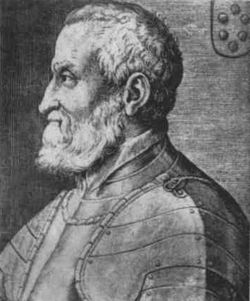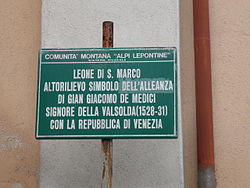- Gian Giacomo Medici
-
Gian Giacomo Medici (c. 1495 – 8 November 1555) was an Italian condottiero, Duke of Marignano and Marquess of Musso and Lecco in Lombardy.
Biography
Gian Giacomo Medici was the brother of Giovanni Angelo Medici, who was later to be elected Pope as Pius IV. They were scions of an impoverished though patrician family of Milan not connected with the Medici of Florence, in spite of the Medici heraldic palle appearing in the contemporary engraving (illustration): thus Gian Giacomo's nickname Il Medeghino, the "little medico".
Gian Giacomo, the eldest of fourteen children, was banished from Milan after a daring murder of revenge in broad daylight. He fled to Lake Como where he gathered about him a band of brigands answerable to none but him. He threw in his lot as bodyguard to the future Duke of Milan, Francesco II Sforza, reinstated in Milan by Emperor Charles V. The Medeghino gained a reputation for unscrupulous violence in the Sforza pay; in partial recompense, he was made Marquis of Marignano on 28 March 1528 (by Imperial patent and confirmed by Francesco Sforza II, Duke of Milan), and also Marquis of Musso and Lecco.
In this connection it is often mentioned that he fled to Lake Como, making it his retreat. This however was not a coincidence, as he was born in Valsolda which is a part of the community of Porlezza. Still today, evidence can be found that Marquis Giacomo di Medici was born in Valsolda and even had a residence in the community of Porlezza. In the main church of Cima, which belongs to the community of Porlezza, an inconspicuous relief can be found which can be seen underneath.
The relief shows the lion of San Marco which is a symbol of the alliance between Gian Giacomo de Medici and the former Republic of Venice. It was put there in honor of his achievements, regarding the unity of Italy. Despite his revolting past he turned into a loyal supporter of the royal family. A description of the relief can be found on a plate next to it:
 Medici's bronze portrait, from his monument in the Cathedral of Milan, by Leone Leoni
Medici's bronze portrait, from his monument in the Cathedral of Milan, by Leone Leoni
Interestingly, when asking the pastor of the local main church in Cima, Gian Giacomo even had a residence in Cima, right on the same spot where now a hotel stands which probably was not called by chance Parco San Marco.[1]
Il Medeghino became a famous condottiere, or soldier of fortune, who fought in the pay of Charles V at the Battle of Mühlberg and elsewhere in Italy (the "War of Siena"), in the Wars of Religion in France and in the Low Countries. The great engineer Agostino Ramelli trained with Gian Giacomo, who instructed him in mathematics and architecture.[2]
In 1543 he purchased the ancient fortified castle of Frascarolo in the Valceresio, which he converted into a sumptuous villa,[3] and in the summer of 1545 he married Marzia Orsini, daughter of Ludovico Orsini, conte di Pitigliano. He was made a knight of the Order of the Golden Fleece in 1555, also the year of his death. Il Medeghino is buried in the Duomo of Milan.
Since his only son, Camillo (died after 1586), was illegitimate, though made a Knight of the Order of Malta, Gian Giacomo's honors passed to his brother Agosto (1501 – 1570).
References
External links
- Medici di Marignano: genealogical notes
Categories:- 1490s births
- 1555 deaths
- People from Milan
- Condottieri
- Italian nobility
- Military leaders of the Italian Wars
- Knights of the Golden Fleece
- Burials at Milan Cathedral
Wikimedia Foundation. 2010.



